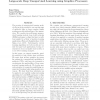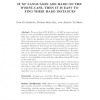674 search results - page 123 / 135 » The computational complexity of the parallel knock-out probl... |
HPDC
2010
IEEE
13 years 8 months ago
2010
IEEE
A common task in biological research is to predict function for proteins by comparing sequences between proteins of known and unknown function. This is often done using pair-wise ...
IPPS
2009
IEEE
14 years 2 months ago
2009
IEEE
Commonly represented as directed graphs, social networks depict relationships and behaviors among social entities such as people, groups, and organizations. Social network analysi...
ICML
2009
IEEE
14 years 8 months ago
2009
IEEE
The promise of unsupervised learning methods lies in their potential to use vast amounts of unlabeled data to learn complex, highly nonlinear models with millions of free paramete...
COCO
2005
Springer
14 years 28 days ago
2005
Springer
We prove that if NP ⊆ BPP, i.e., if SAT is worst-case hard, then for every probabilistic polynomial-time algorithm trying to decide SAT, there exists some polynomially samplable ...
CC
2007
Springer
13 years 7 months ago
2007
Springer
We prove that if NP ⊆ BPP, i.e., if SAT is worst-case hard, then for every probabilistic polynomial-time algorithm trying to decide SAT, there exists some polynomially samplable ...


